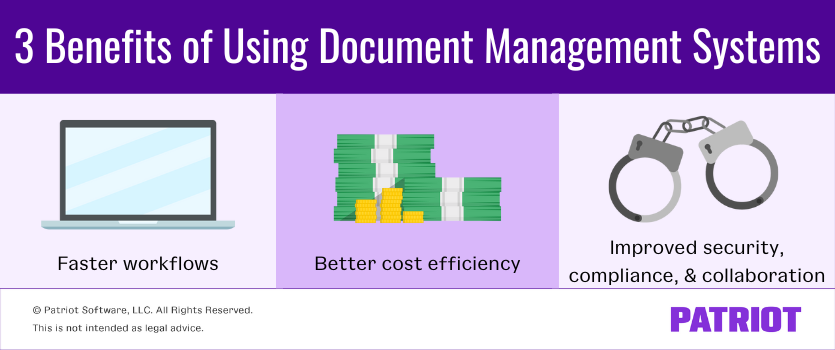Research has found that 46% of employees at small- and medium-sized businesses still waste time on inefficient, paper-related workflows—and on a daily basis. Even with as many companies having transitioned to remote workforces or hybrid workforces, paper persists. But, any company looking to transform or adopt more advanced ways of working digitally needs to rethink its paper-based practices. Using physical files is simply not supportive of modern business practices.
Scanning, tagging, and filing a single page of records can take five minutes (per page, not per record!). Most analysts agree that document management systems are the way to improve efficiencies in a paper-based environment. And, there are several other benefits of using a document management system that can improve your business processes.
Benefits for businesses from document management
Read on to learn the three major ways a document management system delivers important benefits to businesses focused on improving efficiency.

Benefit 1: Faster workflows
A document management system introduces automation into your workflows, streamlining manual processes that once took excess time.
With faster workflows, you can:
- Eliminate the time it takes to move paper from one person’s desk to another
- Speed up approval processes since document management systems move files to and from reviewers electronically
- Help employees avoid wasting time sifting through email inboxes or private folders
- Reduce the number of human errors in your processes
Document management centralizes your company files, so everything is easily findable in one electronic hub. And, it automates tasks such as storage, filing, document creation, distribution, and more.
Your workflows will also improve from a search and retrieve standpoint as document management eliminates the need for employees to sift through physical files in folders or cabinets. This benefit will be especially important if you ever experience an audit because a document management system helps you maintain and track files for compliance. You’ll reduce the time it takes to pull files for an audit—potentially shifting what used to be days down to just hours.
Benefit 2: Better cost efficiency
Without the need to rifle through stacks of paper, you can experience two different forms of cost efficiency:
- Labor cost
- Office cost
Labor cost: Employees can reallocate the time they used to spend searching for documents toward higher-value work that contributes to the growth of your business. This helps you get more out of every labor dollar spent because technology will have taken on those menial, tedious tasks employees aren’t thrilled about. And with more satisfied employees, you may see an uptick in productivity.
Office cost: With a document management system, you can cut back on your need for storage. This means you may not need to lease or buy extra office space with cabinets full of files and paper. Not to mention, you can reduce your annual spend on paper and related tools such as copy machines, envelopes, and more.
Want to impress your friends at a dinner party?
Get the latest small business news delivered straight to your inbox.
Subscribe to Email ListBenefit 3: Improved security, compliance, and collaboration
Document management systems can help prevent you from experiencing document loss—and subsequently, data loss that could compromise your security and compliance adherence.
Depending on the nature of your business, you likely have compliance regulations to abide by. Losing track of any sensitive information on paper could cost you time, money, and headaches. Document management systems ensure that the data on your documents keeps its integrity and your paper stays retrievable in electronic format.
And if you want to properly get rid of documents to ensure security, you won’t have to worry about shredding paper or scribbling out sensitive information. A document management system offers secure archival functions.
You can also set protocols that determine which employees have access to specific documents and what parties can see certain information (aka “version control”). With version control for every file, you can ensure compliance and bolster data security.
Document management systems’ version control and security protocol elements help improve collaboration across the board. In your system, there’s no confusion about who made what change to any file. The paths that documents took throughout your workflows are clear.
Document management systems also make it easier for employees to collaborate by integrating relevant documents, such as email attachments and scanned paper, into one centralized system.
This is not intended as legal advice; for more information, please click here.
These views are made solely by the author.
